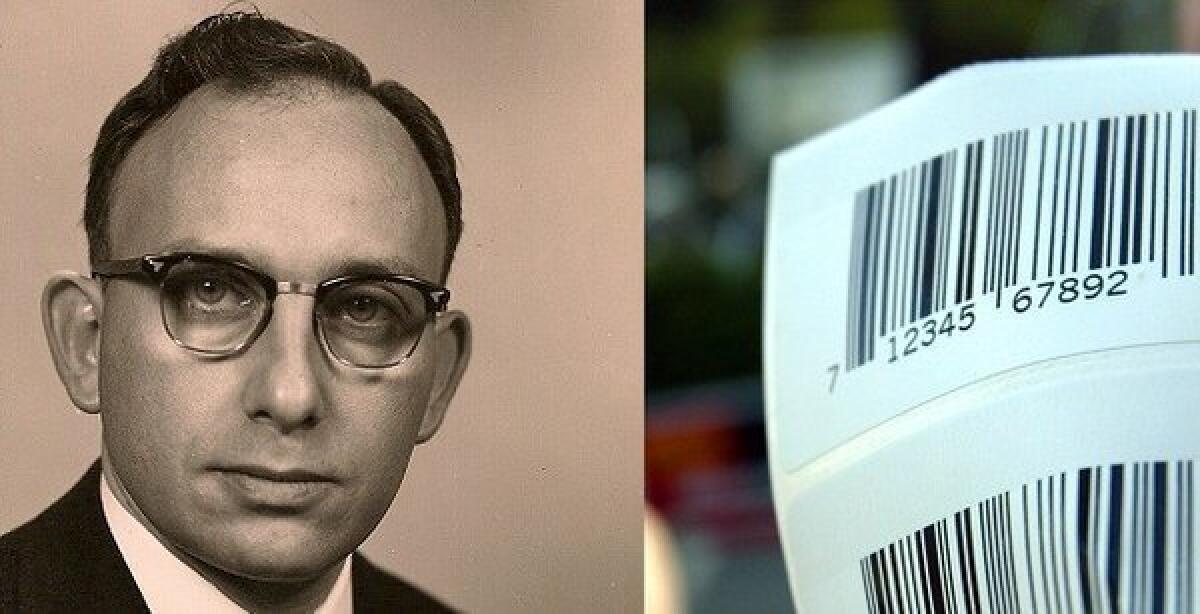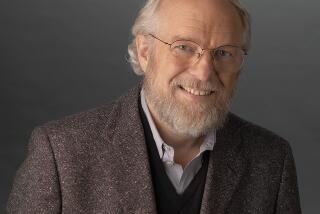N. Joseph Woodland dies at 91; co-inventor of bar code

- Share via
N. Joseph Woodland, a co-inventor of the system of thick and thin lines that became the ubiquitous bar code labeling nearly every product regulated by commerce, has died. He was 91.
Woodland died Sunday at his home in Edgewater, N.J., from the effects of Alzheimer’s disease and complications of his advanced age, said his daughter Susan Woodland.
Woodland and fellow graduate student Bernard Silver developed the bar code at Drexel University in Philadelphia — then called the Drexel Institute of Technology — in the late 1940s. According to Drexel, the head of a local grocery store chain had sought the university’s engineering help in 1948 to advance the checkout process.
Woodland began to focus on developing a code that could symbolically capture details about an item. One day, while spending time with his grandfather in Miami, Woodland found inspiration in the dots and dashes of Morse code that he had learned in the Boy Scouts.
“I was sitting in a beach chair,” he said in a 2004 interview with the Raleigh (N.C.) News and Observer. “I stuck my fingers in the sand, and I drew my hand to me. I left three or four furrows in the sand. I said, ‘Wow. I could have wide lines and narrow lines.’ That was the invention.... It sounds too simple, doesn’t it?”
Woodland and Silver submitted their patent application in 1949 for a code patterned on concentric circles that looked like a bull’s eye. The patent was issued in 1952.
Woodland joined IBM in 1951 hoping to develop the bar code, but the technology wasn’t accepted for more than two decades until lasers made it possible to read the code easily, the technology company said. In the early 1970s, Woodland moved to Raleigh to join a team at IBM’s Research Triangle Park facility. The team developed a bar-code-reading laser scanner system in response to demand from grocers desiring to automate and speed checkout while also cutting handling and inventory management costs.
IBM promoted a rectangular bar code that led to a standard for universal product code technology. The first product sold using a UPC scan was a 67-cent package of Wrigley’s chewing gum at a supermarket in Troy, Ohio, in June 1974, according to GS1 US, the American affiliate of the global standard-setting UPC body.
Today, about 5 billion products are scanned and tracked worldwide every day, including sale items, airline boarding passes, military equipment, hospital patients, livestock and highway toll customers, GS1 US says.
Norman Joseph Woodland was born Sept. 6, 1921, and grew up in Atlantic City, N.J. During World War II, he worked at Oak Ridge National Laboratory in Tennessee as a technical assistant on the Manhattan Project to develop the world’s first atomic bomb.
After the war, Woodland earned his bachelor’s in mechanical engineering from Drexel and a master’s at Syracuse University.
He retired from IBM in 1987. In 1992, he received the National Medal of Technology from the U.S. Patent and Trademark Office, along with Microsoft Corp. founder Bill Gates and six other recipients.
Woodland and Silver, who died in 1963, were inducted into the National Inventors Hall of Fame in 2011.
Besides his daughter Susan, Woodland is survived by his wife, the former Jacqueline Blumberg, whom he married in 1951; a second daughter, Betsy Karpenkopf; a brother, David; and a granddaughter.
More to Read
Inside the business of entertainment
The Wide Shot brings you news, analysis and insights on everything from streaming wars to production — and what it all means for the future.
You may occasionally receive promotional content from the Los Angeles Times.









